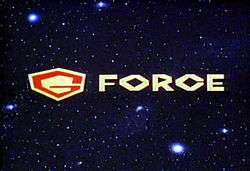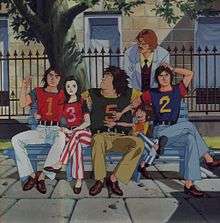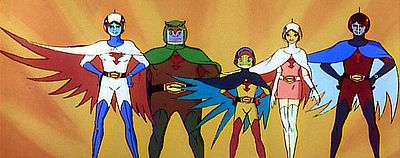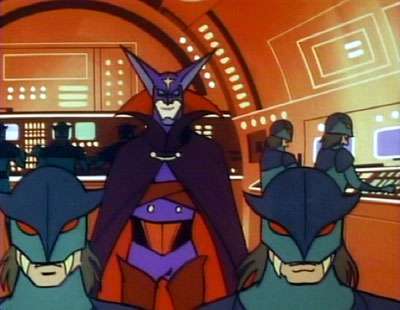G-Force: Guardians of Space
| G-Force (Guardians of Space) | |
|---|---|
 Title screen | |
| Created by |
Turner Program Services King Features Entertainment Sparklin' Entertainment |
| Directed by | Fred Ladd |
| Starring |
Sam Fontana Cam Clarke Barbara Goodson Jan Rabson Gregg Berger Bill Capizzi |
| Country of origin |
United States Japan |
| No. of episodes | 85 (List of episodes) |
| Production | |
| Executive producer(s) | Fred Ladd |
| Running time | 22 minutes |
| Release | |
| Original network | TBS (1986); Cartoon Network (1995-1997, 2000); The Anime Network (2004) |
| Picture format | full-frame |
| Original release | 1986 |
G-Force: Guardians of Space (1986) is the second American animated television adaptation of the Japanese anime series Science Ninja Team Gatchaman (1972), following Sandy Frank Entertainment's initial 1978 effort Battle of the Planets and preceding ADV Films' 2005 attempt, known merely as Gatchaman. With G-Force, Sandy Frank Entertainment collaborated with Turner Broadcasting to create a newer, more faithful translation of Science Ninja Team Gatchaman for a new audience, and such a translation was made possible with the relaxed television standards of the 1980s, a luxury that the more Star Wars-themed Battle of the Planets did not enjoy.
Summary
An excerpt from The Best of G-Force DVD:[1]
Five teen-age champions!
The evil aliens Galactor and Computor, along with their armies of androids and giant monster machines, want to take over the Earth! Galactor will stop at nothing to complete his goal, but fortunately Earth has G-Force - a team of five youngsters willing to lay down their lives to protect the planet! Join Ace Goodheart, Dirk Daring, Agatha June (Aggie), Pee Wee, and Hoot Owl (Hooty) as they fight to keep the Earth safe!
Overview
During the early-to-mid 1980s, Sandy Frank Entertainment's Battle of the Planets (or BotP) was gradually being phased off the air after a successful number of years in syndication. Television stations began relegating the show to early morning timeslots (as typically done with programming on its way off the air) before dispensing of it altogether. During this period Ted Turner's cable network TBS (then known as "SuperStation WTBS") also aired the show on their channel (albeit in a slightly more edited form, with cuts for time constraints), and by 1984, WTBS was more or less the exclusive home of BotP before they too dispensed of it around 1985, effectively ending the lengthy run of Battle of the Planets on U.S television.
With Battle of the Planets having run its course, Sandy Frank, still holding the domestic rights to the first Gatchaman series, continued to market BotP wherever they could while seeking ways to continue making use of their license. Interest came from the part of Turner Broadcasting (who was the last to air BotP on a wide scale on their TBS network) in creating a newer, more faithful adaptation of Gatchaman, which would be easier to accomplish with the newly relaxed television standards of the Reagan era-1980s. (Themes such as violence, death and destruction in cartoons were heavily edited during the 1970s.) Turner executives believed that the series still had potential, and in turn acquired the rights from Sandy Frank to begin work on what would come to be known as G-Force (the same title given to the collective group of protagonists in Battle of the Planets, which in turn would be used for the same purpose on the new version).
To develop this project, Turner enlisted the help of Fred Ladd, a pioneer in the field of translating and distributing Japanese animation in the U.S (with famous works such as Astro Boy, Gigantor & Kimba the White Lion, under his belt) to produce the adaptation. Ladd had previously been offered to produce Battle of the Planets by Sandy Frank himself a few years before, but passed on the offer due to location conflicts; Ladd was working out of New York City at the time, while BotP was being produced in California. Ladd, through his production company "Sparklin' Entertainment", put together two "test" pilot episodes chosen by Turner (see Episode order), and sent them in for approval. Within days, Ladd and his company were given the greenlight to produce the adaptation, and work on G-Force began in the fall of 1986. Despite it being handled by Turner & Fred Ladd, Sandy Frank ultimately held the copyrights to the show (along with international distribution rights), while Turner, through its subsidiary Turner Program Services, and King Features Entertainment (a subsidiary of Hearst Corporation; now Hearst Entertainment) held limited distribution and syndication rights.
Changes and additions in the adaptation

Content editing
For Turner's G-Force, none of Battle of the Planets' original elements (such as 7-Zark-7, 1-Rover-1, the concept of space travel and space battles and all of the added American footage) were retained, preferably replaced with a more accurate translation of the original Gatchaman series with far fewer alterations. Most of the plot, backstories, violence and deaths remained intact, only edited or "softened" with added dialogue where it was too explicit (i.e., certain on-screen gun usage, deaths via firearms and/or overly violent means and inter-team violence).
Music
An all-new music score (by composer Dean Andre) was in the works for G-Force, but those plans fell through due to the time constraints the project faced, which resulted in the adaptation retaining most of the original, 1970s Gatchaman score.
The silent parts of the Gatchaman soundtrack were filled in with additional music. This was a relatively common practice, purportedly to maintain the pace of the show and prevent the audience from losing interest during a lull in action. Battle of the Planets had used this practice, composing new scores as well as reusing the existing Gatchaman music, during silent moments such as mecha transformations (which originally had a high-pitched warping sound effect synchronized with the light beams) and the completely musicless scenes where Katse talked with Sosai X. G-Force: Guardians of Space opted to use a sole, repetitive synth instrumental that would play on and off as the Gatchaman score faded in and out. This synth instrumental is actually a stripped-down rendition of the show's opening/ending theme and is played throughout every episode of the series.
Episode order
Unlike Battle of the Planets, which bounced around the Gatchaman episode order and adapted them as the producers saw fit, G-Force followed the original Gatchaman episode order for its entire run, only skipping Gatchaman episodes 81 (due to intense content, also skipped in BotP) and 86 (for unknown reasons) for a total of 85 dubbed episodes (the same number of episodes adapted for Battle of the Planets coincidentally). However, only the first 87 (85) of Gatchaman's 105 episodes were adapted for G-Force which resulted in the adaptation ending at a cliffhanger, with no definitive ending. The reasons behind this decision are not exactly known; some sources claim that only 85 episodes were contracted and bought for this adaptation while others claim that budget constraints or lack of interest in adapting the remaining episodes cut it short. Also to be taken into consideration is the fact that the Gatchaman series became increasingly darker and violent towards its end, which would have made adapting those last episodes difficult, given that G-Force was being marketed towards children. It was not until ADV Films' uncut and unedited release of the first Gatchaman series in 2005-2006 that all 105 episodes were adapted and available in English.
Episodes 18 ("The Whale Submarine") & 87 ("Galactor's Deadly Trap") of G-Force served as the two pilots for the show. They were put together by producer Fred Ladd before he had been given approval to work on the rest of the series, with the purpose being to demonstrate (to Turner Broadcasting) what his work on the show would look and sound like. The two pilots are unique amongst the rest of the episodes for having replaced all of the original Gatchaman music with new music composed by Dean Andre, which was part of the proposed, all-new music score for the show. Due to time constraints, the new pieces of music weren't utilized beyond the pilots and left on the cutting room floor, with the rest of the episodes retaining most of the original Gatchaman score. Incidentally, most of the new music that was exclusively played in the pilots also turned out to be variations of the show's opening/ending theme. There exist earlier, unaired versions of the pilot episodes which contain a radically different music score than even the broadcast versions of the pilots. They also contain an unused opening/closing theme, which along with the aforementioned score was also left on the cutting room floor in favor of the final music selection present in the broadcast episodes. These "pre-production" pilot episodes are only available as extras on the Region 4 (PAL) Battle of the Planets: Collection 2 DVD set.
Between the efforts of both Battle of the Planets and G-Force, 99 of Gatchaman's 105 episodes were adapted. Incidentally, the last six untranslated episodes were very crucial to the series' overall storyline, and also contained its true ending. They also featured some of the series' most violent, yet memorable moments. As previously mentioned, ADV Film's uncut Gatchaman release finally adapted all 105 episodes into English, more than 30 years after the show first aired and almost 30 years since its first English adaptation.
Character names and terms

On the creative side, the original Gatchaman character names and terms were once-again re-tooled and Americanized in G-Force for the convenience of the English-speaking market, as they first were with Battle of the Planets years earlier. Despite the existence of BotP's set of English names and terms, G-Force's producers came up with their own set in an attempt to stray away from the previous adaptation as much as possible and avoid any potential confusion between the two. From Battle of the Planets to G-Force, the heroes' names were changed to Ace Goodheart (Mark), Dirk Daring (Jason), Agatha June (Princess), Pee Wee (Keyop), Hoot Owl (Tiny), and Dr. Brighthead (Chief Anderson), while the main villains were renamed Galactor (Zoltar) and Computor (The Great Spirit) respectively. The only terms retained from BotP were the name of the group as a collective ("G-Force", in order to explain the "G" on their costumes and vehicles) and the team's ship ("Phoenix").
Other changes
- In G-Force, the Pee Wee character remained mostly identical to his original Gatchaman counterpart Jinpei, as opposed to Battle of the Planets which drastically altered the Jinpei character from a typical 10-year-old to Keyop, a young android with a speech impediment.

- In Gatchaman and Battle of the Planets, the two primary antagonists (known as Berg Katse/Zoltar & Sosai X/The Great Spirit respectively) shared a strictly subordinate/master relationship, which was changed to more of a master/consultant relationship in G-Force, with Galactor (Berg Katse) becoming the master and Computor (Sosai X) now relegated to his consultant. The reasons for this change is due to religious-based criticism disapproving of "The Great Spirit" role that Sosai X had in Battle of the Planets. Scenes with Sosai X were reduced, including ones with Galactor (Katse) bowing to Sosai X.
- Unlike its Gatchaman and Battle of the Planets brethren, G-Force did not have title cards at the beginning of its episodes which made following the show and its individual episodes quite difficult. Foreign-language dubs of G-Force attempted to correct this oversight by having the narrator announce the episode title at the start of each episode. Also, episodes which were listed and titled as two-parters in Gatchaman and Battle of the Planets were not titled as such in G-Force, but the plots in those episodes remained more or less intact. The show's episode titles were later revealed and available to the masses via fan clubs and the internet.
Credits
Owned and distributed by: Sandy Frank Entertainment (formerly marketed by Turner Program Services and King Features Entertainment, whose rights reverted to Sandy Frank in 2003)
Producer: Fred Ladd
Additional Music Composer/Music Editor: Dean Andre
Post-Production: Bruce Austin Productions
Videotape Editor: Kurt Tiegs
Production: Sparklin' Entertainment
Voice cast
Ace Goodheart: Sam Fontana
Dirk Daring/Red Impulse: Cam Clarke (all episodes except 39 & 40)
Agatha June/Pee Wee: Barbara Goodson
Hoot-Owl/Dr.Brighthead/Computor: Jan Rabson (some episodes), Gregg Berger (others)
Galactor: Bill Capizzi
Opening Credits Announcer: Norm Prescott
(NOTE: The show's voice actors were originally uncredited in its credits list.)
Team variations across different versions
The renaming of the various characters and terms in G-Force are highlighted as follows (in correspondence to their Gatchaman equivalents, among others):
| Gatchaman | Battle of the Planets | G-Force | Eagle Riders | OVA (Harmony Gold Dub) | Rank | Bird Uniform | Weapon | Mecha | Japanese voice actor | Voice actor (BOTP) | Voice actor (G-Force) | Voice actor (Harmony Gold OVA Dub) | Voice actor (Eagle Riders) | Voice actor (ADV TV/Sentai OVA dub) |
|---|---|---|---|---|---|---|---|---|---|---|---|---|---|---|
| Ken Washio | Mark | Ace Goodheart | Hunter Harris | Ken the Eagle | G1 | Eagle | Razor boomerang | Airplane | Katsuji Mori | Casey Kasem | Sam Fontana | Eddie Frierson | Richard Cansino | Leraldo Anzaldua |
| Joe Asakura | Jason | Dirk Daring | Joe Thax | Joe the Condor | G2 | Condor | Pistol | Race Car | Isao Sasaki | Ronnie Schell | Cam Clarke | Richard Cansino | Bryan Cranston | Brian Jepson |
| Jun | Princess | Agatha June ("Aggie") | Kelly Jennar | June the Swan | G3 | Swan | Yo-yo | Motorcycle | Kazuko Sugiyama | Janet Waldo | Barbara Goodson | Lara Cody | Heidi Noelle Lenhart | Kim Prause |
| Jinpei | Keyop | Pee Wee | Mickey Dugan | Jimmy the Falcon | G4 | Swallow | Bolo | Dune Buggy | Yoku Shioya | Alan Young | Barbara Goodson | Mona Marshall | Luci Christian | |
| Ryu Nakanishi | Tiny Harper | Hoot Owl ("Hooty") | Ollie Keeawani | Rocky the Owl | G5 | Owl | Pistol | God Phoenix | Shingo Kanemoto | Alan Dinehart | Jan Rabson/Gregg Berger | Richard Epcar | Paul Schrier | Victor Carsrud |
- Although he was obviously the Swallow, Jimmy called himself the Falcon.
Other character variations across different versions
| Gatchaman | Battle of the Planets | G-Force | Eagle Riders | OVA (Harmony Gold Dub) |
|---|---|---|---|---|
| Dr. Kozaburo Nambu | Chief Anderson | Dr. Benjamin Brighthead | Dr. Thaddeus Keane | Dr. Kozaburo Nambu |
| ISO Director Anderson | President Kane | Anderson/Cmdr. Todd (some episodes) | Anderson | Director Anderson |
| Red Impulse / Kentaro Washio | Col. Cronos | Red Impulse / Kendrick Goodheart | Harley Harris | Red Spectre / Kentaro Washio |
| Berg Katse | Zoltar | Galactor | Lukan | Solaris |
| Sosai (Leader) X | O Luminous One / The Great Spirit | Computor | Cybercom | Lord Zortek |
| Galactor | Planet Spectra | Galactor or Galactor's men | Vorak | Galactor |
| Gel Sadra (Gatchaman 2) | Mallanox |
Identity change variations across different versions
| Variations | Gatchaman (Japanese) | Battle Of The Planets | Guardians Of Space | Eagle Riders | OVA (Harmony Gold dub) | Gatchaman (English) | ||||||||||
|---|---|---|---|---|---|---|---|---|---|---|---|---|---|---|---|---|
| Identity Change Command | Bird, Go!‡ | Transmute! | G-Force, Transform! | Eagle Mode, NOW! |
|
Bird, Go! | ||||||||||
| Planet/Civilization | Selectol (planet) Gyarakutā (civilization) | Spectra | Galactor | Vorak | Galactor | Selectol (planet) Galactor (civilization) |
‡The original Japanese language version of Gatchaman contains a small amount of words in English.
Debut and reception
TBS run (1986)
The revamped G-Force premiered as a "test run" on Turner's own TBS network in the summer of 1986 and ran for just a week before mysteriously disappearing afterwards. The reasons for this are still unclear and/or unknown, but it wasn't on long enough for viewer receptions or higher-ups to even gauge its viability as some have indicated. Supposedly, it was replaced by re-runs of Gilligan's Island the following week. Some sources say that G-Force was created solely for overseas syndication (and not U.S. consumption), and that the purpose behind the TBS "test run" was to clear a contractual agreement and also list the show as having "aired" in the U.S. to help it sell around the world. Regardless of whether this was true or not, the show was syndicated internationally in the following years, finding a decent following abroad while the U.S. was left without any incarnation of Gatchaman for years.
Cartoon Network run (1995-1997; 2000)
Almost a decade later, Cartoon Network, another of Ted Turner's networks and still in its infancy was in dire need of newer and fresh programming, which conveniently provided an opportunity for G-Force to make its (proper) U.S. debut, as Turner still had a stake in the show at the time. G-Force premiered on Cartoon Network on January 2, 1995 as a mainstay of the network's action programming, and was finally aired in its entirety via weekday and weekend rotation.
G-Force was the first-ever anime to air on Cartoon Network, followed by Robot Carnival, Vampire Hunter D, Twilight of the Cockroaches (all three on January 29, 1995 in "Night of the Vampire Robots") and Speed Racer (February 1996), all airing before the debut of Toonami (March 1997) which popularized anime on the network.
The show did modestly rating-wise and developed a small following, but neither were on the scale that Battle of the Planets had and enjoyed in its day. More notable was the mass confusion that occurred amongst older viewers upon the premiere of G-Force. Many who recalled and were fans of its predecessor Battle of the Planets were confused and thrown off upon watching G-Force (due to both being culled from the same material, Gatchaman and prominently using the name "G-Force"), assuming it was an altered version of BotP at first and not a newer, entirely separate adaptation of Gatchaman.
By 1996, Cartoon Network shunted the show to late nights and weekends only, and it lingered there for a while until they finally cancelled it in 1997, marking the last time G-Force has aired in its entirety in the U.S to date. Since its original U.S run, the show has made brief re-appearances in 2000 (on Cartoon Network's late-night "Toonami Midnight Run" block) and again in 2004 (on ADV's "The Anime Network"), never airing more than a handful of episodes.
During its short stint on the weekend "Toonami Midnight Run" block in early 2000, G-Force was featured in a number of on-air promotions for Cartoon Network's Toonami, which continued to air even after the show had left the air.
Reception
G-Force was (and still is) criticized by fans of the previous adaptation, Battle of the Planets, and to a lesser extent Gatchaman, both of which criticize its voice acting and "descriptive" character names, preferring their Gatchaman/BotP equivalents. Also, as previously mentioned, the similarity between BotP and G-Force has often led to fans of the former confusing it with the latter, when they are, in fact, two different English adaptations of the same show. The most common complaint amongst fans and new viewers alike was the distracting synth instrumental that was often played in every episode. These flaws proved to be enough for some to overlook G-Force's good qualities and avoid the show altogether, and all this among other factors (such as Cartoon Network not having had a strong national presence during the show's original U.S. run) resulted in G-Force failing to be as successful as Battle of the Planets was.
DVD releases and availability
Due to its relative obscurity, and paired with the fact that ADV's recent uncut and unedited Gatchaman release has replaced it as the most accurate English adaptation, G-Force is unlikely to receive a full series or boxset release as its Battle of the Planets breathren has received (in the U.K at least[2]).
Also, Sandy Frank Entertainment's (owners of both Battle of the Planets and G-Force: Guardians of Space) distribution and marketing rights to the original Gatchaman series, including its adaptations, were believed to have recently expired, leaving the fates of both G-Force and its predecessor Battle of the Planets up in the air and most likely killing the already slim probability of any future G-Force releases on DVD.
To date only a handful of G-Force episodes have been released on home video, totaling to just 13 of its 85 episodes when adding up all of the ones in the following DVD releases:
- The Best of G-Force (Region 1 NTSC DVD released on September 28, 2004): A compilation DVD featuring seven random G-Force episodes, mostly out of episode order.
- G-Force: Guardians of Space (Region 0 PAL DVD released on May 13, 2003): Eponymously titled DVD featuring the first three G-Force episodes.
- Battle of the Planets Volumes 1-6 (Region 1 NTSC DVDs released between 2001 and 2002): The first six volumes of Rhino's Battle of the Planets release contain one episode of G-Force per volume as "extras" (Episodes 1-6, in the same order as the respective volumes). After Volume 6 this practice was stopped.
Further reading
- G-Force: Animated (TwoMorrows Publishing: ISBN 978-1-893905-18-4)
- Astro Boy and Anime Come to the Americas: An Insider's View of the Birth of a Pop Culture Phenomenon (McFarland & Company; Incorporated Publishers: ISBN 0-7864-3866-5)
References
- ↑ "The Best of G-Force: G-Force: Movies & TV". Amazon.com. Retrieved 2013-09-03.
- ↑ "Battle of the Planets Mega Box Set [DVD]: Amazon.co.uk: Alan Dinehart, David E. Hanson: Film & TV". Amazon.co.uk. Retrieved 2013-09-03.
External links
- G-Force: Guardians of Space at the Internet Movie Database
- G-Force: Guardians of Space at TV.com
- Gatchaman (anime) at Anime News Network's encyclopedia